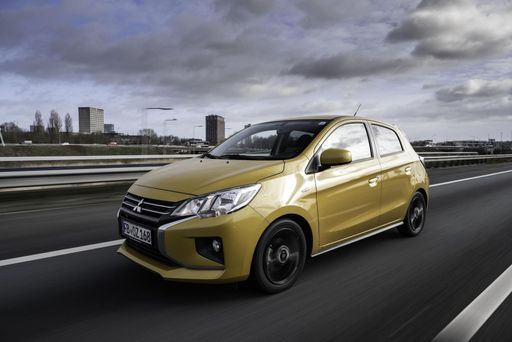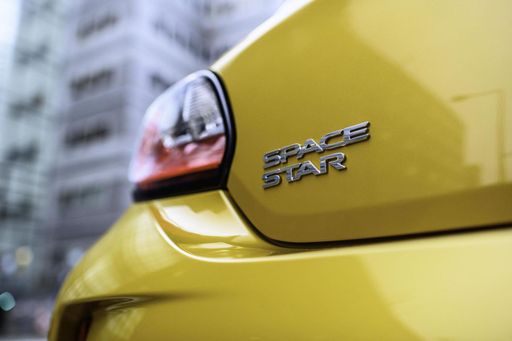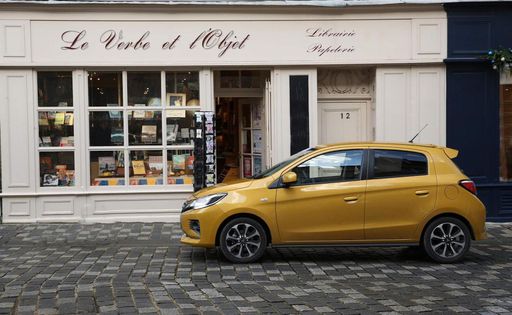Mitsubishi Space Star vs Vauxhall Rocks Electric – Differences & prices compared
Compare performance, boot space, consumption and price in one view.
Find out now: which car is the better choice for you – Mitsubishi Space Star or Vauxhall Rocks Electric?
The Mitsubishi Space Star (Hatchback) comes with a Petrol engine and Manuel or Automatic transmission. In comparison, the Vauxhall Rocks Electric (Hatchback) features a Electric engine with Automatic transmission.
When it comes to boot capacity, the Mitsubishi Space Star offers 235 L, while the Vauxhall Rocks Electric provides 63 L – depending on how much space you need. If you’re looking for more power, decide whether the 71 HP of the Mitsubishi Space Star or the 8 HP of the Vauxhall Rocks Electric suits your needs better.
In terms of consumption, the values are 4.90 L per 100 km for the Mitsubishi Space Star, and for the Vauxhall Rocks Electric.
Price-wise, the Mitsubishi Space Star starts at 11600 £, while the Vauxhall Rocks Electric is available from 6800 £. Compare all the details and find out which model fits your lifestyle best!
Mitsubishi Space Star
The Mitsubishi Space Star offers a compact yet surprisingly spacious experience, making it an ideal choice for urban dwellers who need agility and comfort. Its sleek design is complemented by a range of vibrant colour options, adding a touch of flair to everyday commutes. With a focus on efficiency and practicality, the Space Star combines a user-friendly interface with modern technology to ensure a smooth driving experience.
details @ presse.mitsubishi-motors.de
@ presse.mitsubishi-motors.de
 @ presse.mitsubishi-motors.de
@ presse.mitsubishi-motors.de
 @ presse.mitsubishi-motors.de
@ presse.mitsubishi-motors.de
 @ presse.mitsubishi-motors.de
@ presse.mitsubishi-motors.de
Vauxhall Rocks Electric
The Opel Rocks Electric stands out as a stylish and compact solution for urban mobility, offering both convenience and an eco-friendly commute. Its sleek design and vibrant colour options make it an attractive choice for those looking to navigate city streets with ease. This nimble vehicle not only promises a smooth ride but also enhances the overall urban driving experience.
details

|
|
|
|
|
Costs and Consumption |
|
|---|---|
|
Price
11600 - 18700 £
|
Price
6800 - 7500 £
|
|
Consumption L/100km
4.9 - 5.5 L
|
Consumption L/100km
-
|
|
Consumption kWh/100km
-
|
Consumption kWh/100km
-
|
|
Electric Range
-
|
Electric Range
75 km
|
|
Battery Capacity
-
|
Battery Capacity
5.40 kWh
|
|
co2
112 - 125 g/km
|
co2
0 g/km
|
|
Fuel tank capacity
35 L
|
Fuel tank capacity
-
|
Dimensions and Body |
|
|---|---|
|
Body Type
Hatchback
|
Body Type
Hatchback
|
|
Seats
5
|
Seats
2
|
|
Doors
5
|
Doors
2
|
|
Curb weight
940 - 1009 kg
|
Curb weight
558 kg
|
|
Trunk capacity
209 - 235 L
|
Trunk capacity
63 L
|
|
Length
3845 mm
|
Length
2410 mm
|
|
Width
1665 mm
|
Width
1388 mm
|
|
Height
1505 mm
|
Height
1525 mm
|
|
Payload
360 - 400 kg
|
Payload
142 kg
|
Engine and Performance |
|
|---|---|
|
Engine Type
Petrol
|
Engine Type
Electric
|
|
Transmission
Manuel, Automatic
|
Transmission
Automatic
|
|
Transmission Detail
Manual Gearbox
|
Transmission Detail
Reduction Gearbox
|
|
Drive Type
Front-Wheel Drive
|
Drive Type
Front-Wheel Drive
|
|
Power HP
71 HP
|
Power HP
8 HP
|
|
Acceleration 0-100km/h
14.1 - 15.8 s
|
Acceleration 0-100km/h
-
|
|
Max Speed
163 - 167 km/h
|
Max Speed
45 km/h
|
|
Torque
102 Nm
|
Torque
40 Nm
|
|
Number of Cylinders
3
|
Number of Cylinders
-
|
|
Power kW
52 kW
|
Power kW
6 kW
|
|
Engine capacity
1193 cm3
|
Engine capacity
-
|
General |
|
|---|---|
|
Model Year
2020 - 2023
|
Model Year
2025
|
|
CO2 Efficiency Class
C, D
|
CO2 Efficiency Class
A
|
|
Brand
Mitsubishi
|
Brand
Vauxhall
|
Mitsubishi Space Star
Introducing the Mitsubishi Space Star: A Perfect Blend of Efficiency and Innovation
The Mitsubishi Space Star continues to impress urban drivers with its compact yet efficient design. Celebrated for its practicality and fuel economy, this hatchback offers a unique blend of new-age technology and reliable performance. Let’s dive into some of the technical details and innovations that make the Space Star a popular choice among compact car enthusiasts.
Engine and Performance
The Space Star is powered by a 1.2-litre, 3-cylinder petrol engine, delivering a respectable 71 PS (52 kW). The engine provides a harmonious balance of power and efficiency, reaching a top speed of up to 167 km/h. With a torque of 102 Nm, drivers can expect smooth city rides and decent highway cruising capabilities. The Space Star's economy ranges from 4.9 to 5.5 litres per 100 kilometres, ensuring that your journeys remain budget-friendly and environmentally considerate.
Transmission and Driving Dynamics
When it comes to the driving experience, buyers have the option of a 5-speed manual transmission or a CVT automatic. This flexibility allows for a more personalised driving experience, whether you prefer the engagement of manual shifting or the convenience of an automatic gearbox. The car's front-wheel-drive setup further enhances its maneuverability, making it an ideal companion for navigating tight city streets.
Design and Dimensions
The Mitsubishi Space Star is designed to turn heads with its sleek, aerodynamic lines while maintaining a practical size. Measuring 3845 mm in length, 1665 mm in width, and 1505 mm in height, it's a perfect fit for urban driving. Despite its compact form, the Space Star offers five seats and five doors, providing ample accessibility and comfort for both the driver and passengers.
Interior Features and Comfort
Inside, the Space Star prioritises comfort and convenience with thoughtfully designed interiors. The luggage space ranges from 209 to 235 litres, ideal for shopping trips or weekend getaways. The vehicle comes in a variety of trim levels, including Basis, Plus, Select, and Top, with each offering distinct features to meet different customer needs. Whether you need basic amenities or more premium touches, the Space Star has a version that will suit your lifestyle.
Safety and Environmental Impact
Safety innovation is a hallmark of the Mitsubishi Space Star, ensuring peace of mind for drivers and passengers alike. Its CO2 efficiency class ranges from C to D, with emissions between 112 to 125 g/km, reflecting its dedication to reducing the environmental footprint. These features contribute to making the Space Star a responsible choice for the eco-conscious driver.
Cost of Ownership
Affordability is another attractive aspect of the Space Star. Prices range from €13,590 to €21,790, making it accessible for a wide array of budgets. Running costs are equally competitive, with monthly expenses estimated between €627 and €767, and cost per kilometre ranging from 25.1 to 30.7 cents, all contributing to a car that is as economical to own as it is to drive.
Conclusion
In summary, the Mitsubishi Space Star offers a compelling package of efficiency, practicality, and modern technology. Its combination of fuel economy, flexible transmission options, and affordability make it a standout choice in the compact car segment. For those looking for a reliable and economical city car, the Space Star remains a strong contender that shouldn't be overlooked.
Vauxhall Rocks Electric
Introducing the Opel Rocks Electric
The world of electric mobility continues to expand with innovative vehicles, and the Opel Rocks Electric is at the forefront of this evolution. Embracing a sustainable future, this compact urban mobility solution combines distinctive styling with practical features, appealing particularly to city dwellers seeking an efficient and environmentally friendly mode of transportation.
Distinctive Design and Dimensions
Measuring just 2410 mm in length, 1390 mm in width, and 1520 mm in height, the Opel Rocks Electric boasts a compact design that makes navigating through narrow city streets a breeze. Despite its diminutive size, it offers a surprising amount of space with a clever two-seater configuration. The vehicle’s quirky and modern appearance clearly distinguishes it from conventional cars, while the available Klub and Tekno trims tailor its aesthetic to match individual preferences.
Technical Brilliance of Electric Power
Under the hood, the Opel Rocks Electric prioritises eco-friendliness with a completely electric powertrain. The battery capacity of 5.4 kWh powers an 8 PS (6 kW) motor, which delivers a maximum torque of 40 Nm. This configuration is ideal for urban environments, providing sufficient punch for everyday city commutes while maintaining energy efficiency.
Range and Efficiency
The vehicle’s electric range is rated at 75 km on a full charge, making it perfect for short daily trips or running errands around the city. With a top speed restricted to 45 km/h, this car falls into the light four-wheeler category, granting road use eligibility for certain groups, such as young drivers.
Comfort and Practicality
The innovative design extends beyond functionality to include comfort and convenience. The two-seat configuration offers ample space for driver and passenger, and with a boot capacity of 63 litres, there’s room for essentials and shopping bags. Additionally, its lightweight architecture, with a kerb weight of 471 kg, enhances efficiency and agility.
Safety and Sustainability
The Opel Rocks Electric’s commitment to sustainability and safety is evident in its design and operation. It achieves a commendable CO2 efficiency class of A and produces zero emissions, aligning with global efforts to combat climate change. This electric mobility solution is as kind to the planet as it is to the wallet, with an attractive price range of €8,340 - €9,140.
Conclusion
The Opel Rocks Electric represents a bold step forward in urban transportation, blending sustainable technology with convenience. For those seeking an eco-friendly, efficient, and stylish way to move around the city, this electric car is an excellent choice, reflecting Opel's dedication to innovation in mobility.
The prices and data displayed are estimates based on German list prices and may vary by country. This information is not legally binding.
